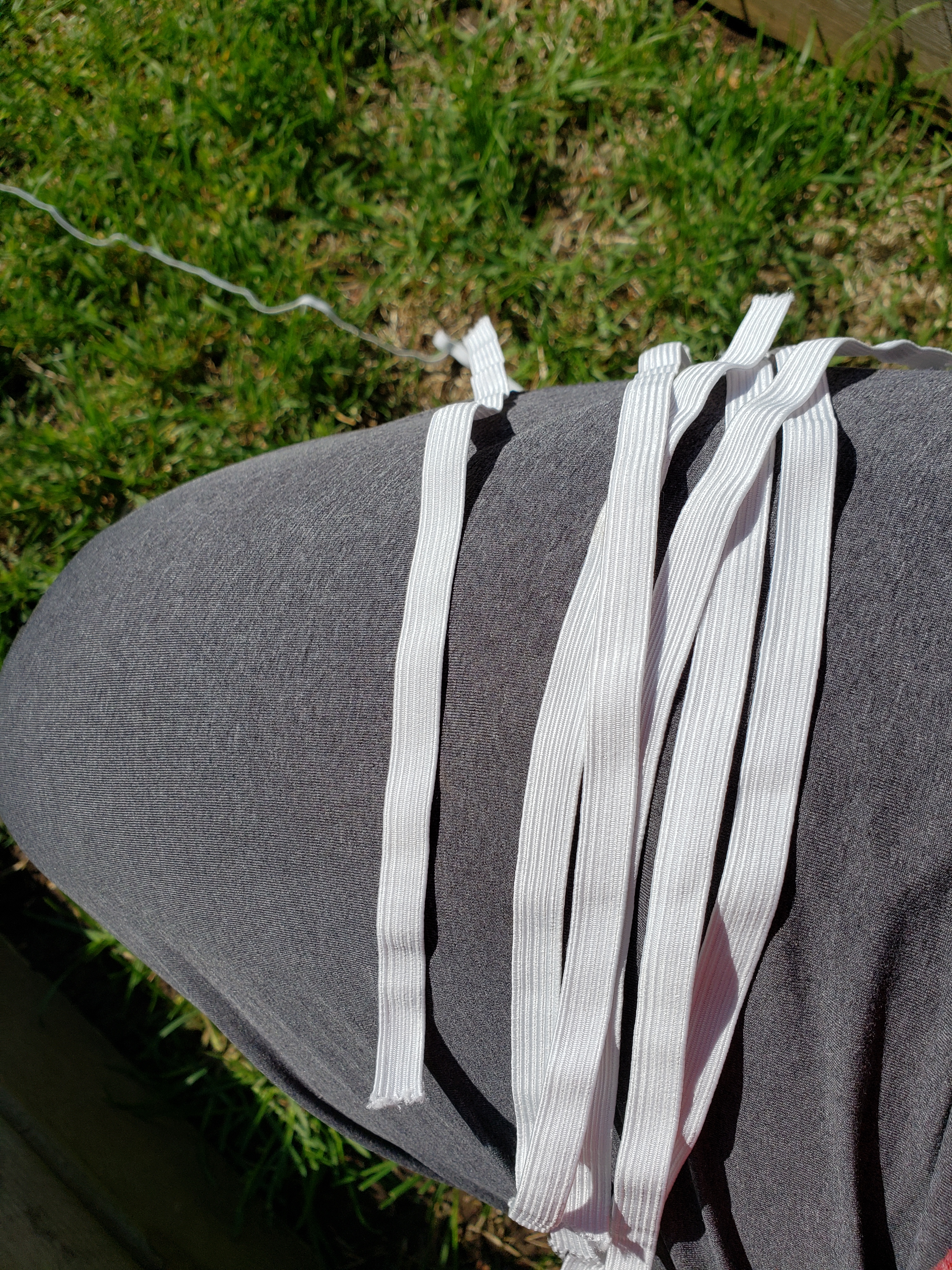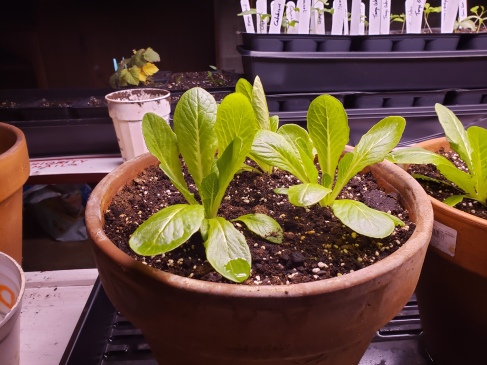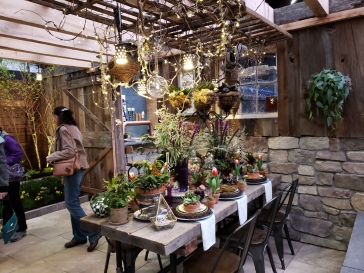As I mentioned in an earlier post, one of my goals for the winter was to do the advance planning for my vegetable garden. It’s nice to do it now rather than in the rush of spring. I have time to look at my journal from last year (yes, I keep a planting and harvest journal) and see what worked and what didn’t. Before I get into what I hope to have in store for this year….a little background is in order.
In the Beginning….
We moved into our current house in August of 2016. The big back and side yards were part of what attracted us to it. I immediately declared the south side of the house, a section hidden by fence, as the new “vegetable garden area”. The whole area is maybe 20’x 35′. It gets sun all day, but due to the mature cypress hedge on our southern border, part of it is sightly shaded. It was too late for a garden that year. So I sat, and I waited. Plotting and scheming the whole time. During that wait, I fell in love with the concept of Square Foot Gardening. At our last residence, I ignored conventional row gardening anyway and packed everything in as dense as I could, as a result I had some great yields. So this seemed like a logical step forward to me.
Spring arrived and I came out of the gate hard. I built nine raised beds, 3’x 6’x 8″ out of pressure treated lumber. I used fence boards to make it more economical as they are pretty cheap and the beds wouldn’t be that high, so sides collapsing wasn’t a concern. And I ordered up a load of topsoil. Here is where it went bad. The topsoil was nothing more than this real fine, screened clay. I cut it with compost and as much organic matter I could get my hands on. But it wasn’t near enough. That first season, I had serious compaction and drainage problems. Everything was stunted and only a few of the real hardy things did well. I was expecting some problems, just not to that extent.
Next season I added manure and raised bed soil to all the beds and mixed it in as much as I could. I also noticed last season that the beds have a nice worm population which I took as a good sign. Things were much better last year. I planted a ton of different stuff. I had zucchini and cherry tomatoes in such quantity, that I was sick of them long before the season ended. I started a bunch of stuff inside from seed and that gave me a nice jump on a few things.
This time around
So here we are in 2019. What is my plan this year? This year I am going to start replacing a few of the beds with something a little more hardy. I plan to keep the same size as it is good for working. I just want to use some sturdier lumber and build some cold frame tops for a few of the beds. As for Square Foot Gardening, I am going to stick with it, but ease back on the density just a bit. Especially with beans. I think it will help improve yield. I also plan on adding more organic matter to all of the beds this year. probably more raised bed soil and maybe a little composted manure.
I plan on having a good variety of stuff again this year, just at a more manageable level. So here it goes:
Green Beans and Yellow Wax Beans: I will plant half a bed of each. I prefer bush beans to pole beans, just easier to work with. The dog does too, because she likes to steal them when I am not looking. I have a lot of “Provider” Green Bean seed left over from last year. So I just need to buy more yellow. And I will stagger the plantings by a few weeks.
Red Butter Lettuce and Romaine Lettuce: I had these in beds previously, this year they go into pots on the deck. Too many critters having their way with them last year. Plus then in the heat of the high summer, I can move them to partial shade to help get a handle on bolting.
Swiss Chard: I suddenly can’t get enough of this. I planted Rainbow Chard last season and it went nuts, and I went nuts for it. But I will scale it back to three plants instead of the six I had last season. Not everyone feels the same way about it as I do so I had problems trying to give away the excess.
Zucchini: Okay, so last season I had about 6 plants…..I didn’t have the heart to toss the extra seedlings so I found them a home. My freezer is still stuffed with vacuum sealed bags of zucchini. This year…..1 plant. Maybe a second later in the season, we will see.
Yellow Squash: See Zucchini…..same story just a different colored vegetable.
Potatoes: One of the beds I plan on re-building is the potato bed. This way I can make it deeper. I plan on half a bed of Pontiac Red and half a bed of Yukon Gold. Last year I got a lot of earlies which was great.
Tomatoes: I have been a tomato junkie since I was little. I love them. I planted a few oddballs last year just playing around and grew a lot of Romas. This year I plan on scaling it back a little. No Roma. Just Cherokee Purples, Sweet Cherries and some Brandywines. I am also trying a new seed by Burpee, called “Steakhouse Hybrid”. It’s a giant indeterminate Beefsteak type with fruits upwards of 3 pounds. I like odd things, what can I say.
Cucumbers: These are my wife’s favorite an one of mine. I grow them every year. This time I plan on trellising them in a bed along my deck. I have doe it before with decent success.
Peppers: I tried a ton of different varieties last year. I had great success with Aji Dulci’s, but I will not be repeating that. I gave most away. This year, Green Bells, Red Peppers, Ancho Chilis, Jalepenos and a variety I discovered last season called “Sweet Chocolate”. Dark chocolately flesh, very sweet.
Kale: I have been growing Tuscan Kale for several seasons now. I does great in upstate New York. It really gets it second wind in the fall with the cooler nights.
Broccoli: I haven’t had a lot of luck with it the past few seasons. This year I plan on just a few plats, but growing them in pots . This way if I fail again, I haven’t wasted precious bed space.
Carrots: The bed for carrots is the second bed I plan on re-building this year. For the same reason as the potato bed. I want more depth. Like the beans, I will stagger the plantings a few weeks apart. They store good in the ground, but they are vulnerable when out there. So I would rather have a fresh batch every few weeks and take them direct to table.
Corn: Last year was a corn fiasco. I started a batch inside. Got the seedlings outside and they never really progressed. So I started over from seed. Good germination and the corn got about 5 feet tall, then the wind storm came after a few days of heavy rain and put a hurting on it. On top of all that, the deer ravaged the corn patch. So….fencing this year. Plus some tall stakes and guide lines to keep the corn straight.
Delicata Squash: I am trying this out for the first time. My plan is to grow it in this huge pot I saved from a fruit tree I bought. I am a huge squash fan and everyone raves about these. Plus,they are pretty pricey if you want organic. So I can hopefully get a good yield and feast cheaply.
Melon: I am trying a new hybrid of cantaloupe called “Mango hybrid”. I have a little spare bed space, so I plan on giving it a lot of room and see what it can do.
Brussel Sprouts: I may try these….not sure yet. I have been eating a lot of them lately, so I thought why not give a stab at growing them?
And although not vegetables, I plan on adding some Blackberries along my southern fence. It seems like a good use of space and I love blackberries. Hopefully my blueberries will come back a little harder this year too. Last year they performed poorly.
Lastly, I found a northern hardy fig. It’s a bush, not tree,, and I have a spot in full sun in the back yard where I have the remains of a stump to pull out. This wold be the perfect spot for it. It’s a variety called “Violet de Bordeaux”.
So that’s the plan. Seems aggressive doesn’t it? It’s a lot of growing in a little bit of space, but that is the essence of what suburban gardening is all about. How much can I produce? If I can make the soil a little better and fertilize when I am supposed to this season, who knows how much I will get. I do keep a harvest journal. I weight everything as I pick and compare it to what it costs at the local grocer. Last season I grew just under $400 worth of produce. This year I want better yields, and my goal is $600 or more.
So that’s it. Any thoughts comments or experience would be appreciated. I enjoy hearing the wisdom of others. I would rather learn from your mistakes whole I have a chance. Just like I invite you to learn form mine.
























































 My enthusiasm seems to grow along with them. One thing I did notice is that the heat mats require more frequent watering. Not a lot, but noticeably more than last year. I am okay with that. I tend to it all daily, like an impatient, hovering parent. I expect in another 10-14 days, maybe a little less, I will start seeing peppers. Peppers were a hard spot last year. It took a log time because my basement was so cool. The plants were small when I moved them outside, and were stunted for the season. This year I am hoping for bigger plats, for a bigger yield. .
My enthusiasm seems to grow along with them. One thing I did notice is that the heat mats require more frequent watering. Not a lot, but noticeably more than last year. I am okay with that. I tend to it all daily, like an impatient, hovering parent. I expect in another 10-14 days, maybe a little less, I will start seeing peppers. Peppers were a hard spot last year. It took a log time because my basement was so cool. The plants were small when I moved them outside, and were stunted for the season. This year I am hoping for bigger plats, for a bigger yield. . So I am pleased that things are moving along. The warmer weather makes me impatient to get out there, so having something to do is a nice distraction. The snow is gone, the finches are changing colors, and in the mornings when I leave for work, I can hear birdsong. Now is also when I also start stocking up on supplies such as: fertilizer, copper fungicide for the squash, melons and cucumbers, Epsom salts and calcium. I mix Epsom salts and calcium and give the beds with the peppers and tomatoes a good shot of that. That helps prevent blossom end rot and a number of other deficiencies they are prone to. My raised bed soil is deficient in micro nutrients and last year I didn’t use nearly enough. I ended up having to foliar feed to treat symptoms and I would rather stay ahead of this time and have improved plant health in order to see increased yields.
So I am pleased that things are moving along. The warmer weather makes me impatient to get out there, so having something to do is a nice distraction. The snow is gone, the finches are changing colors, and in the mornings when I leave for work, I can hear birdsong. Now is also when I also start stocking up on supplies such as: fertilizer, copper fungicide for the squash, melons and cucumbers, Epsom salts and calcium. I mix Epsom salts and calcium and give the beds with the peppers and tomatoes a good shot of that. That helps prevent blossom end rot and a number of other deficiencies they are prone to. My raised bed soil is deficient in micro nutrients and last year I didn’t use nearly enough. I ended up having to foliar feed to treat symptoms and I would rather stay ahead of this time and have improved plant health in order to see increased yields. That’s all I have to cover for now. In a few weeks I may update again, if some meaningful change has occurred. Until then, play for warmth.
That’s all I have to cover for now. In a few weeks I may update again, if some meaningful change has occurred. Until then, play for warmth. 






































